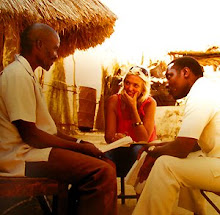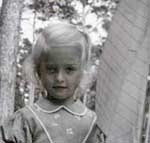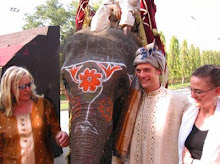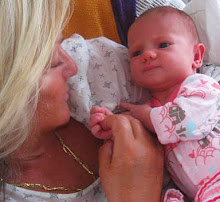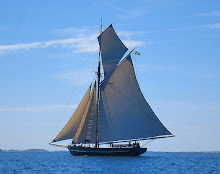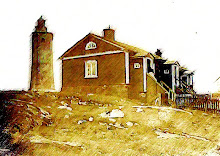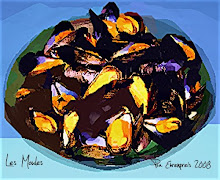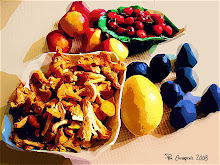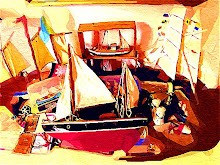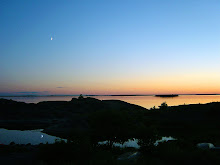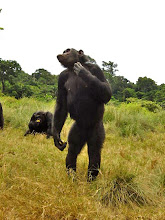






 The boat that took us from the mainland to the island if Sandhamn the evening before Midsummer! The following morning, we found it had sunk and couldn´t believe what we saw!
The boat that took us from the mainland to the island if Sandhamn the evening before Midsummer! The following morning, we found it had sunk and couldn´t believe what we saw! Midsummer everning at the house of good, old friends at Sandhamn was a great comfort! The house has a wonderful view of the sea and the weather was great! And so was the food - heering, shrimps, eel, smoked whitefish with beer and snaps! And strawberry cake for dessert - or pudding as the English would say!
Midsummer everning at the house of good, old friends at Sandhamn was a great comfort! The house has a wonderful view of the sea and the weather was great! And so was the food - heering, shrimps, eel, smoked whitefish with beer and snaps! And strawberry cake for dessert - or pudding as the English would say! Ok. I live in Paradise. And today summer came to Gotland!
Ok. I live in Paradise. And today summer came to Gotland! My niece Stella is the first one in the COLD water! She frolics and splashes around for quite sometime! Brrrr..
My niece Stella is the first one in the COLD water! She frolics and splashes around for quite sometime! Brrrr.. As for me?OH no -over my dead body! Too cold! I pretend cowardly be very busy watching the beautiful scenery of this lovely island!
As for me?OH no -over my dead body! Too cold! I pretend cowardly be very busy watching the beautiful scenery of this lovely island! Tomorrow I am off heading for Midsummer celebrations on the smaller island of Sandhamn in the Stockholm archipelago..Maybe there, I will dip a toe in or so. Anyway the rumors are that the turbot is on in the Baltic. I will for sure go fishing instead. At least some encounter with this element!
Tomorrow I am off heading for Midsummer celebrations on the smaller island of Sandhamn in the Stockholm archipelago..Maybe there, I will dip a toe in or so. Anyway the rumors are that the turbot is on in the Baltic. I will for sure go fishing instead. At least some encounter with this element! 
Eurocard Round Gotland Race is a classic offshore regatta - one of the largest in the world. Start and finish is in Sandhamn, in the Stockholm archapelago. To the 2010 race the following classes are invited: IRC Endorsed, ORC Int. SRS and One Design Classes with more than 8 participantes. Baltic Classic Race are held at the same time. This is a regatta for classic yachts.
 ..my daughter Lina and her husband Pontus happily called to inform me they finally bought a gorgeous apartment downtown Stockholm.
..my daughter Lina and her husband Pontus happily called to inform me they finally bought a gorgeous apartment downtown Stockholm. It is situated close to the water and parks on a nicely treed avenue. I figured it was quite high time since she is due with their first child in a few days! And live in an old, crammed one room apartment for the moment where not even a baby´s dressing table could fit in!
It is situated close to the water and parks on a nicely treed avenue. I figured it was quite high time since she is due with their first child in a few days! And live in an old, crammed one room apartment for the moment where not even a baby´s dressing table could fit in! The building used to an the old postoffice in Stockholm which have now been totally remodeled by wellknown architects. This is what it looks like. There is quite som celing hight, huge windows and with open plan arrangement.
The building used to an the old postoffice in Stockholm which have now been totally remodeled by wellknown architects. This is what it looks like. There is quite som celing hight, huge windows and with open plan arrangement. ..far into the deep woods of northern Gotland, I found her, the wonderfully scented
..far into the deep woods of northern Gotland, I found her, the wonderfully scented The forest was filled with a variety of orchids - en masse! Trips to these areas must have been a highlight in Swedish botanist, physician, and zoologist, Carl von Linné´s (who laid the foundations for the modern scheme of binomial nomenclature) excursions all over Gotland in the mid 1800-century.
The forest was filled with a variety of orchids - en masse! Trips to these areas must have been a highlight in Swedish botanist, physician, and zoologist, Carl von Linné´s (who laid the foundations for the modern scheme of binomial nomenclature) excursions all over Gotland in the mid 1800-century. Sunday, we went with a group of people and a guide to visit the iron age (500 BC – 800 AD) village of Höglundar (by Garde gård, Stenkyrka), deep into the woods. During this period, the climate in the Nordic area grew colder. Rainy summers and harsher winters led to lower yields from crops and farm animals. When iron came to the North in about 500 BC, it brought with it considerable changes however. Unlike bronze, iron was an inexpensive metal that could be used in everyday life – for tools, weapons and many other things.
Sunday, we went with a group of people and a guide to visit the iron age (500 BC – 800 AD) village of Höglundar (by Garde gård, Stenkyrka), deep into the woods. During this period, the climate in the Nordic area grew colder. Rainy summers and harsher winters led to lower yields from crops and farm animals. When iron came to the North in about 500 BC, it brought with it considerable changes however. Unlike bronze, iron was an inexpensive metal that could be used in everyday life – for tools, weapons and many other things. The we spotted the foundation of a typical Gotland long house (I have one like this just behind my house!)
The we spotted the foundation of a typical Gotland long house (I have one like this just behind my house!) (A reconstruction in Gotland)
(A reconstruction in Gotland) Our guide, Per-Åke, (sitting, ) is himself living on farm close to Lickershamn not far from where we were, which stands on the foundtions of a iron-age dwelling. The farm has been passed on for "he did not quite know many gererations!" There he found the skeleton of "Gotland´s oldest human being" some years ago. It is now placed in the Gotland Fornsal museum. He has also found a number of treasures on his farm: silver, iron items, brons and claypots.
Our guide, Per-Åke, (sitting, ) is himself living on farm close to Lickershamn not far from where we were, which stands on the foundtions of a iron-age dwelling. The farm has been passed on for "he did not quite know many gererations!" There he found the skeleton of "Gotland´s oldest human being" some years ago. It is now placed in the Gotland Fornsal museum. He has also found a number of treasures on his farm: silver, iron items, brons and claypots. A beautiful Juniper tree in the middle of the Höglundar woodlands!
A beautiful Juniper tree in the middle of the Höglundar woodlands! .. and ever so beautiful!
.. and ever so beautiful! June, June oh June! The peonies are now in full bloom!
June, June oh June! The peonies are now in full bloom!  May I introduce my "almost domestic" phesant who is constantly yammering and marking his territory in the garden.Today, I managed finally to get a photo of this proud fellow! We have been knowing eachother for quite sometime now! So I am now levelling for a bit with my sister with her 6 peacocks in her neighbouring farm!
May I introduce my "almost domestic" phesant who is constantly yammering and marking his territory in the garden.Today, I managed finally to get a photo of this proud fellow! We have been knowing eachother for quite sometime now! So I am now levelling for a bit with my sister with her 6 peacocks in her neighbouring farm!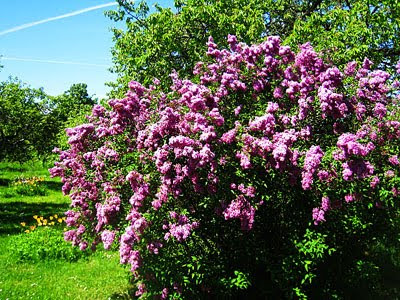 The gorgious "Turkish" lilac outside my window! Heavy, heavy..
The gorgious "Turkish" lilac outside my window! Heavy, heavy.. Tomorrow I will spend quite a few hours on my lawnmower! The weather forecast is great for Tuesday with a warm sunshine predicted - a day for gardening indeed. Friday and Saturday are a bit more uncertain though... There are prognoses for some rain which might interfere for a bit the great Royal wedding that will take place in Stockolm on Saturday! And the Swedes are now keeping their fingers crossed for fair weather and blue skies on this festive occation!
Tomorrow I will spend quite a few hours on my lawnmower! The weather forecast is great for Tuesday with a warm sunshine predicted - a day for gardening indeed. Friday and Saturday are a bit more uncertain though... There are prognoses for some rain which might interfere for a bit the great Royal wedding that will take place in Stockolm on Saturday! And the Swedes are now keeping their fingers crossed for fair weather and blue skies on this festive occation!Lat: N 59º 16' 47.67"
Long: E 18º 45' 38.30"
Runmarö lies at Nämdöfjärden, outside of Stavsnäs on the main land.
There are hundreds of islands and skerries in the archipelago surrounding the island. The main island is one of the largest in the middle archipelago and in the villages, which consist primarily of genuine traditional archipelago buildings, you will find more than one hundred permanent residents.
 The island is mentioned in writings from the 13th century, which tell that Magnus Ladulås gave the island to the Franciscan Order in Stockholm. The existence of limestone on the island was already important at that time and it was quarried and calcinated until the middle of the 17th century. Limestone from here was used to build the castle Tre Kronor in Stockholm. The island has also played its part in the Swedish military history. From here Gustav II Adolf shipped out some of his fleet of 1400 men in 27 warships to Prussia to participate in the 30 Years War. As in so many other parts of the archipelago, the Russians ravaged the island in the attempt to invade Stockholm in 1719. Remains from that time, Russian ovens, i.e. fire boxes that were used for heat and cooking can still be seen today.
The island is mentioned in writings from the 13th century, which tell that Magnus Ladulås gave the island to the Franciscan Order in Stockholm. The existence of limestone on the island was already important at that time and it was quarried and calcinated until the middle of the 17th century. Limestone from here was used to build the castle Tre Kronor in Stockholm. The island has also played its part in the Swedish military history. From here Gustav II Adolf shipped out some of his fleet of 1400 men in 27 warships to Prussia to participate in the 30 Years War. As in so many other parts of the archipelago, the Russians ravaged the island in the attempt to invade Stockholm in 1719. Remains from that time, Russian ovens, i.e. fire boxes that were used for heat and cooking can still be seen today. View towards the island of Sandhamn far away.
View towards the island of Sandhamn far away. 
 The lightning struck long time ago and the tree is trying to heal..
The lightning struck long time ago and the tree is trying to heal.. Newlyweds!!
Newlyweds!! In view of the forthcoming Royal wedding in Stockholm - the Swedes are living in a veritable wedding daze! In Skansen , (the first open air museum (1833-1901) to show the way of life in the and zoo in Sweden located on the island Djurgården in Stockholm, Sweden.) launched a mass wedding day on Saturday!
In view of the forthcoming Royal wedding in Stockholm - the Swedes are living in a veritable wedding daze! In Skansen , (the first open air museum (1833-1901) to show the way of life in the and zoo in Sweden located on the island Djurgården in Stockholm, Sweden.) launched a mass wedding day on Saturday! The civil ceremony was estimated to 10 minutes whereas the religious church ceremony took a bit longer! Skanen personel was on their knees because " No one here expected the enormous interest.." And the priests and civil clerks looked a bit tired towards the end of the day - to say the least!
The civil ceremony was estimated to 10 minutes whereas the religious church ceremony took a bit longer! Skanen personel was on their knees because " No one here expected the enormous interest.." And the priests and civil clerks looked a bit tired towards the end of the day - to say the least! One of the 350 couple who got married at Skanen on Saturady in one of the small wedding tents erected for the occation.
One of the 350 couple who got married at Skanen on Saturady in one of the small wedding tents erected for the occation.

